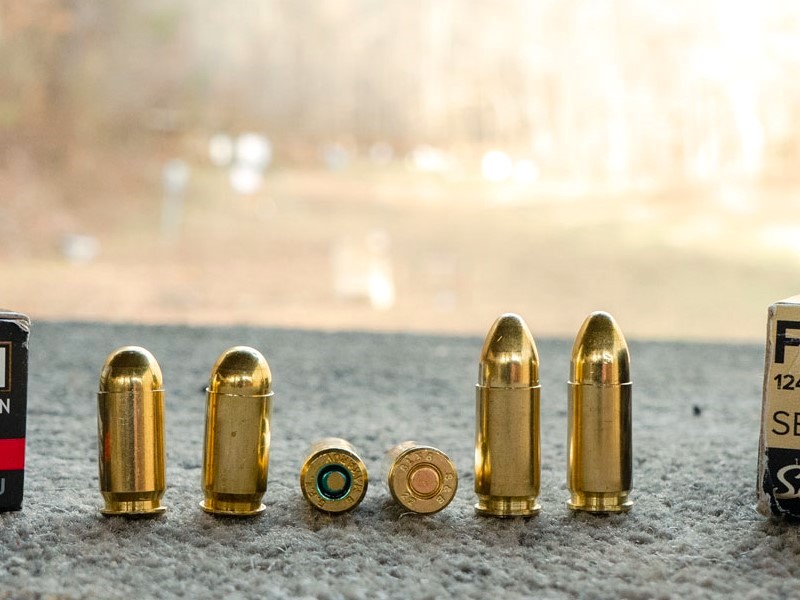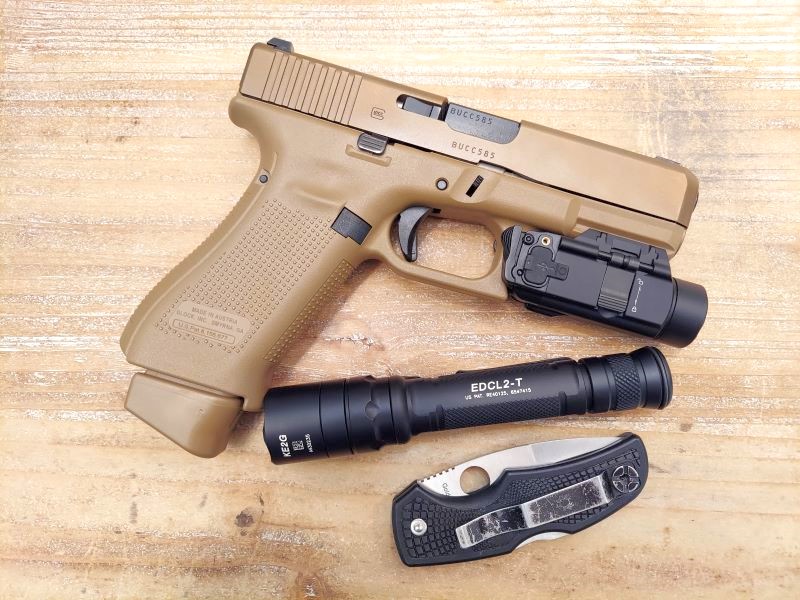The Luger and the Makarov are both 9mm, but are they the same? What are the differences? Are they equally effective?
Let us dig up some answers!
Each Cartridge’s History
9x19mm Luger (Parabellum, NATO)
The 9mm Luger dates back to 1901 when Georg Luger presented it to the world. It has soldiered on for over 120 years and shows no signs of slowing down. It has been in use by most of the Western world, both in the military and civilian world. It’s one of the most popular rounds in both pistols and submachine guns.
9mm Makarov
In 1946, Boris Semin developed the 9mm Makarov cartridge. Nikolay Makarov developed the Makarov PM pistol in the 9×18 Makarov round in 1947. The Soviets adopted the 9×18 Makarov PM and the cartridge in 1951.
Bore Diameter Differences
Although both cartridges are designated as “9mm”, they have different diameters. The 9mm Luger fires a cartridge with a diameter of 0.355 inches, and the Russian Makarov’s diameter is 0.363 inches.
The reason for the difference is the measuring methods of the two nations. The Russians use an older method of measuring the bore diameter by measuring the distance across the lands of the rifling. A newer method of measure is used by The US and NATO, which is to measure the distance across the grooves of the rifling. As a result, the Russian rounds have a slightly larger diameter.
Some authorities theorize that the Russians did this to prevent their enemies from being able to use their 9mm rounds in Russian weapons.
Case Length Differences
The 9mm Luger cartridge will not fit into the chamber of a 9×19 Makarov chamber because they have different case lengths. Specifically, the 9mm Luger’s case length is 19.15mm (.754 inches). The 9×18 case length is 18.10mm, or .713 inches. Because of that, it’s impossible to chamber a 9mm NATO round into a Makarov chamber.

Even if it were possible to stuff a 9mm Luger round into a Makarov chamber, the Luger’s round, being smaller than the Makarov, would not engage the rifling of the Makarov’s barrel. It would essentially bounce around going down the barrel, which would make it completely inaccurate.
Aside from that, the overall length of the 9mm Luger is longer than the Makarov. The 9mm Luger is 1.169 inches, whereas the 9×18 Makarov is 0.984 inches.
Differences in Bullet Weight
The most popular bullet weights in the 9mm NATO cartridge lineup are 115, 124, and 147 grains. There are other commercial bullet weights that we sometimes run into, but the first three are the most popular.
As for the 9×18 Makarov, the most popular bullet weight is 95 grains.
Case Capacities and Pressures
Because the 9×19 case is longer, it has a higher powder capacity of 13.3 grams. The Makarov, on the other hand, has a capacity of 12.8 grams.
Because of its higher case capacity, the 9×19’s maximum pressure is 35,000 pounds per square inch (psi) per SAAMI specifications. The Makarov’s is 23,500 psi.

The Makarov round is used in pistols with a blowback recoil system. The blowback system cannot handle higher pressures, for the most part, than what the 9×18 round produces. Aside from that, the blowback system is economical and simple to produce.
Considering that the 9x19mm has higher chamber pressures, it’s typically used in pistols with a locked breech design. Our next section will explain why this is significant.

Recoil
Most people don’t care for recoil. It can be not only uncomfortable, but it slows down follow-up shots during shooting. It can also cause shooters to flinch when squeezing off shots.
Free Recoil is a measurement of recoil that is objective and utilizes several factors, including bullet weight, muzzle velocity, firearm weight, and powder charge. The 9×18 Makarov technically has less free recoil than the 9x19mm. However, shooters report that the 9×18 usually feels as though it has more recoil than the 9mm NATO round.

Other factors include the weight of the pistol and how hot the rounds are. The pistol’s grip also has a substantial influence on how recoil is perceived; some excellent grips can mitigate a lot of discomfort. The reason for this is the design of the handgun; the Makarov has a blowback action, which is why the recoil feels sharper. With it, the only thing to mitigate the pistol’s recoil is the recoil spring. The 9mm locked-breech system tends to soften the felt recoil for shooters.
I can personally testify to this. My dad used to have a little 9×18 Hungarian Makarov pistol. I grew to strongly dislike firing that pistol because the recoil stung my hand. It felt rather like swinging a baseball bat into a metal light post. All of the energy of the round seemed to transfer directly into my hand, making range trips an unpleasant experience with that pistol.
Ballistic Performance
The 9×19’s higher case capacity means that it is superior in every manner ballistically to the 9×18 Makarov. The 9mm can fire a heavier projectile faster than the Makarov.
Let’s compare the two with a few common cartridges and see how they differ.
In 9mm Makarov:
- 95-grain Full Metal Jacket Fiocchi: 1020 feet per second with 219 foot-pounds of energy.
- 95-grain Hornady Critical Defense FTX Jacketed Hollow Point: 1000 feet per second with 211 foot-pounds of energy.
In 9mm Luger:
- 115-grain Winchester Full Metal Jacket: 1,190 feet per second with 362 foot-pounds of energy.
- 124-grain Jacketed Hollow Point V-Crown Sig Sauer: 1,165 feet per second with 374 foot-pounds of energy.
We can see that the 9mm throws a heavier round faster, which is going to equate to better terminal performance on target, without a doubt. And the weight difference isn’t tiny, either, it’s enough to be significant.
The 9mm Luger also enjoys a flatter trajectory at 100 yards than does the 9x18mm. While the 9x18mm bullets dropped approximately 10 inches at 100 yards, the 9x19mm rounds only dropped around seven inches at the same distance. Granted, that’s not a massive difference, and we’re not very likely to be firing at targets or threats 100 yards away. However, it still gives an illustration of the differences in performance between the two rounds.
Is the 9×18 an ineffective pipsqueak? Not at all. There’s just good, and then there’s better.
Bullet Design
While ammunition manufacturers have come up with some rounds to address the 9x18mm for the defensive market, let’s face it, the round is not at the top of their list. Or anyone’s list, really. It’s not a super common self-defense caliber. As such, ammo development for it is not going to be a priority.
The 9x19mm, on the other hand, is probably Number One on the priority list for ammo development, given its wild popularity. And this is even more so in the last few years as agencies, departments, and civilians are migrating from the .40 cal. back to the 9mm in droves. This is due to the fact that the 9mm does not have the higher chamber pressures of the .40 cal., nor does it beat up guns as badly, it has less recoil, and is cheaper to purchase.
Consequently, the amount of research that has gone into, and still goes into, developing more effective 9mm projectiles and ammunition is second to none. Companies keep coming up with better and better rounds.
On the flip side, there just aren’t very many options for defensive ammo in 9×18 Makarov.
Aside from bullets, 9mm handguns are also in a constant state of development. Whether it’s duty pistols, competition pistols, the newer micro-nines, or military pistols, the guns are evolving before our very eyes. And we haven’t even touched on submachine guns and pistol caliber carbines (PCC), which are entirely another facet of weaponry!
Speaking of which, I’m not aware of any PCCs that fire the 9×18 Makarov round. However, there are loads of them that shoot 9x19mm. It’s undeniable that the number of platforms to fire 9x19mm far outweighs those for the 9×18.
Availability and Price
To put it bluntly, 9x19mm ammunition is far more available than the 9mm Makarov, and it’s cheaper, too.
The 9mm is available pretty much wherever bullets are sold. To find 9mm Makarov, you may have to do some hunting. And when you do find it, you’ll pay more for it. The Biden Administration’s recent ban on the importation of Russian ammunition does not help the 9×18’s cause at all, making the ammo even more scarce. A few US makers do manufacture 9×18, but nowhere near the volume that they do for 9x19mm.
As for bullet launchers, the 9×19 again enjoys a massive advantage. Glock, Sig, S&W, H&K, Beretta, Taurus, and a couple of dozen others make 9x19mm handguns all day long.

With the 9×18 Makarov…not so much. In fact, I’m aware of no US makers, or major handgun makers anywhere, manufacturing guns for it.
Parting Shots
If you happen to own an older 9×18 Makarov pistol, don’t feel as though you have to get rid of it immediately. Stoked with the right ammunition, it should serve you relatively well for defense or plinking.
However, the 9x19mm will be cheaper to maintain and purchase ammunition for. And that ammunition will perform better than the 9×18 Makarov in every aspect. Not only will the ammunition perform better, but also very likely the pistol that you’re shooting it from.
From a price, availability, and performance standpoint, we have a winner—the 9×19 Luger/Parabellum/NATO!


